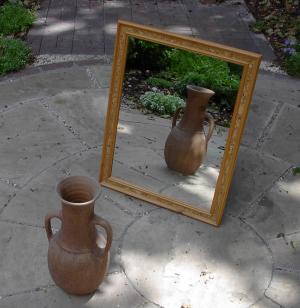Reflections on the Behavior of Light
Whether Diffuse or Normal, Through Reflection is Most Often How We See the Light
Anonym
When considering the nature of light and color, it makes sense to ask in what ways does light behave? An inclusive list of the basic categories of behavior for light would most likely include transmission, absorption, reflection, refraction, diffraction, scattering, polarization and interference. Of these, only the first three - transmission, absorption and reflection - are needed to account for all of the electromagnetic energy, or light, which falls upon an object.

"Tso Kiagar Lake Ladakh" by Prabhu B - Licensed under CC BY 2.0 via Commons
Light rays that are reflected or transmitted may become polarized, and transmitted light may be scattered or refracted. Any light that is neither reflected or transmitted is absorbed, and adds to the internal heat energy of the material at an atomic or molecular level. Taken together, the changes that light goes through as a result of all of these processes is responsible for all that may be seen.

Original work by author based on illustration in "Light And Color" published by Golden Press, 1971
The most fundamental behavior of all of these is probably reflection. For being such a critical phenomenon of nature, the laws that describe the reflection of light are remarkably simple.
Laws Of Reflection
- The angle of reflection equals the angle of incidence.
- Incident and reflected light rays lie in the same plane.
- Incident and reflected light rays are on opposite sides of the normal line passing through the point of incidence and perpendicular to the reflecting surface.

"Reflection angles". Licensed under CC BY-SA 3.0 via Commons
At the microscopic level, all reflection is regular, which is a way of saying that one can visibly perceive that the reflected light conforms to these laws. In the everyday macroscopic world, regular reflection is only perceived off of mirror-like surfaces. With regular reflection, one doesn't see the object that the light reflects off of, such as the surface of a polished mirror, but rather the objects that are reflected by it. A plane mirror reverses the scene it reflects, with objects on the left appearing to the right in the mirror image, and everything appearing to be as far behind the mirror's surface as they are in fact in front of it.

"Mirror" by Cgs - English Wikipedia - Licensed under CC BY-SA 3.0 via Commons
Reflection is almost completely regular from a mirror because of the mirror's smooth, highly polished surface. A rough surface will present many different very small angles of incidence for light to reflect off of, so macroscopically the overall reflection will be diffuse. The wavelength of visible light averages something like 500 nm, so by comparison most surfaces are rough and therefore diffusely reflect light. A fairly smooth surface, such as that of a road when it is wet, can exhibit both regular and diffuse reflection, in proportions which will vary with the angle of the incident light.

"Diffuse reflection" by Theresa Knott at the English language Wikipedia. - Licensed under CC BY-SA 3.0 via Commons
What will happen when light is shone on an object really depends on the material that object is made out of. Polished metal reflects almost all of the light that hits it, absorbs some, and transmits effectively none. An object such as a black tarp appears dark because it is absorbing much of the light that is falling on it. Most materials exhibit some selectivity in the different wavelengths of light that they will reflect, transmit and absorb. Gold reflects red and yellow wavelengths more strongly than it does blue. Silver tends to reflect all wavelengths equally, making it appear almost white. A purple cloth will reflect blue and red wavelengths, but absorb green light. The intrinsic color of any object is almost always due to the selective reflection and absorption characteristics of its constituent materials.

"Gold-crystals" by Alchemist-hp - Licensed under CC BY-SA 3.0 via Commons
Remote sensing isn't only done with high-end sensors from an orbiting platform. It's what happens when we see. In order to perceive a non-luminous object with our eyes, at least some light has to reflect off of it. As basic of a concept as that is, it's not a bad starting point for pondering how light behaves.